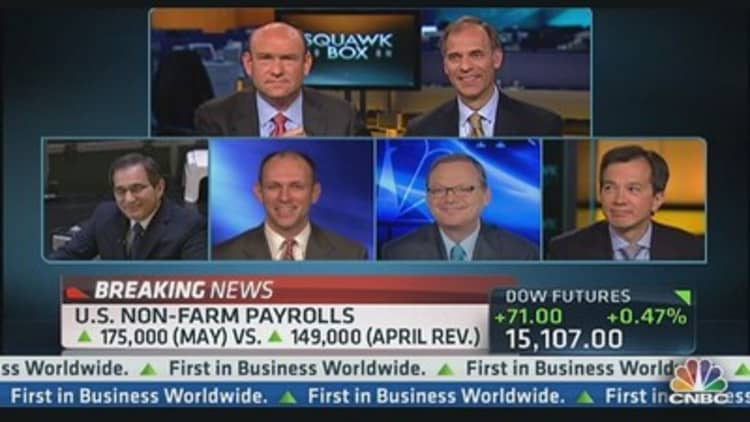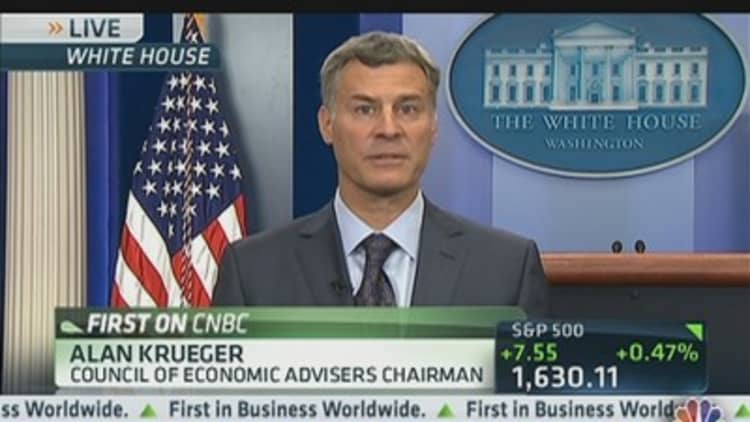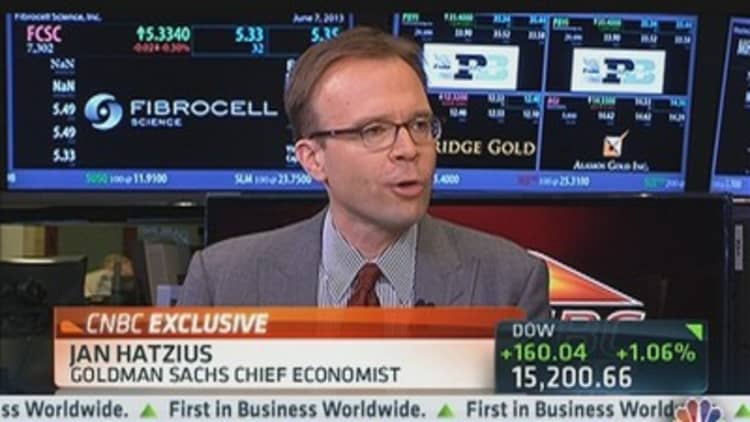Despite anticipation of a spring-into-summer swoon, the U.S. economy continued to create jobs at a relatively steady pace in May, adding 175,000 positions as the unemployment rate ticked higher to 7.6 percent.
Economists expected nonfarm payrolls to grow by 170,000 in the month after an initial reading of 165,000 in April, which was lowered to 149,000.
An alternative unemployment measure that includes the underemployed and those who have quit looking edged lower to 13.8 percent.
"The employment report does not look too bad after all, which should soothe recent concerns over a slowing for the US economy in response to domestic fiscal policy and external headwinds," Andrew Wilkinson, chief economic strategist at Miller Tabak, said of the report.

Investors have been watching the employment picture for clues on Federal Reserve policy.
The Fed has been pumping $85 billion a month of liquidity into the system through purchases of Treasurys and mortgage-backed securities.
However, some members have indicated recently that the Fed ought to begin backing off the program, which has swelled the central bank's balance sheet past $3.4 trillion.
"It doesn't move the needle much either in terms of the market or in terms of when Fed tapering begins," said Liz Ann Sonders, chief investment strategist at Charles Schwab. "It's good news. There was a whisper number that indicated we could get a really bad number, and that would have been the worst-case scenario for the market."
As it stood, the stock market loved the number and surged higher in early trading.
The Fed has stated a goal of 6.5 percent unemployment and inflation of 2.5 percent before it starts normalizing interest rates, though asset purchases are likely to wind down before that happens.
Former Fed Chairman Alan Greenspan told CNBC that the central bank ought to begin reducing its purchases, known as quantitative easing.
(Read More: Greenspan: Taper Now, Even If Economy Isn't Ready)
The unemployment rate had been moving lower in large part because of a reduction in those looking for jobs. That metric, the labor force participation rate, ticked higher to 63.4 percent in May after hitting a 35-year low in March and April.

Services led job creation, while retail and the food service industries also contributed.
Long-term unemployment got worse, with average duration up to 36.9 weeks. Unemployment for blacks rose to 13.5 percent, while the Latino rate ticked higher to 9.1 percent.
"This was sort of the best that we could get, which is no change in Fed policy and the economy is continuing about the same pace as we had in the past," said Kate Warne, investment strategist at Edward Jones. "The reaction is going to be modestly positive. It doesn't really solve the (Fed) issue, because we're still slower than anyone would like."
The numbers got a huge lift as well from a formula—called the "birth-death model"— that the Labor Department uses to estimate the number of jobs that new businesses created or lost. That estimate added 205,000 to the count.
In all, the monthly jobs survey showed 319,000 more Americans working while the number of those unemployed also rose, by 101,000.
Government payrolls shed 14,000 as budget sequestration cuts began to kick in, but those cuts were offset by hiring at the state level.

"The sequester, along with the negative impact from slowing global trade, are being offset by the continued contribution from the revival in the housing market and stronger consumption," said Kathy Bostjancic, director of macroeconomic analysis at The Conference Board.
Wages were flat for the month, while the average work week was unchanged at 34.5 hours.
The May payrolls number has been both low and volatile over the past several years, with an average initial reading of 69,000 and an average upward revision of an additional 99,000 positions.
Other jobs numbers had pointed to a slowdown.
The Institute for Supply Manufacturing surveys of both the manufacturing and nonmanufacturing sectors pointed to flat growth, while the ADP/Moody's Analytics survey of private payrolls earlier this week came in considerably lower than expected.
While April's job gains suffered a downward revision, the March count rose slightly from 138,000 to 142,000.
(Get the full Bureau of Labor Statistics report here.)
_ By CNBC's Jeff Cox. Follow him on Twitter @JeffCoxCNBCcom.


